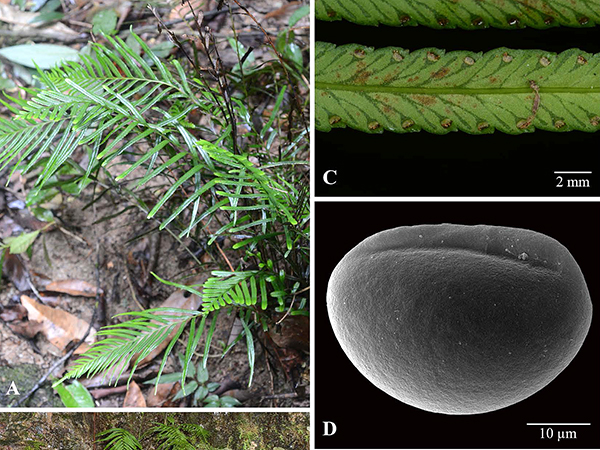A revision of the genus Tapeinidium (Lindsaeaceae) in Thailand
DOI:
https://doi.org/10.20531/tfb.2018.46.2.07Keywords:
conservation assessment, Davallia, fern, lectotypification, pteridophyteAbstract
A revision of the genus Tapeinidium (C.Presl) C.Chr. in Thailand is presented based on herbarium specimens and field surveys. Two species are recognized, namely Tapeinidium luzonicum (Hook.) K.U.Kramer and T. pinnatum (Cav.) C.Chr. A key to species, descriptions, photographs and conservation assessments are provided. In addition, issues with the previous lectotypifications of Davallia luzonicum Hook. and D. pinnata Cav. are resolved.
Downloads
Download data is not yet available.
References
Cavanilles, A.J. (1802). Descripción de las Plantas. Imprenta Real, Madrid. 625 pp.
Christensen, C.F.A. (1906). Index Filicum: sive enumeratio omnium generum specierumque filicum et hydropteridum ab anno 1753 ad finem anni 1905 descriptorum adjectis synonymis principalibus, area geographica etc. Hafniae [Copenhagen] H. Hagerup. 744 pp.
Holttum (1955 [‘1954’]). A revised Flora of Malaya, an illustrated systematic account of the Malayan flora, including commonly cultivated plants. Vol. 2. Ferns of Malaya. Edition 1. Government Printing Office, Singapore. 643 pp.
Hooker, W.J. (1846). Species Filicum 1. W. Pamplin, London. 245 pp.
Kramer, K.U. (1968 [‘1967’]). The Lindsaeoid ferns of the Old World II. A revision of Tapeinidium. Blumea 15(2): 545–556.
________. (1971). Lindsaea Group. Flora Malesiana, Series 2, Pteridophyta 1(3): 177–254.
Lehtonen, S., Tuomisto, H., Rouhan, G. & Christenhusz, M.J.M. (2010). Phylogenetics and classification of the pantropical fern family Lindsaeaceae. Botanical Journal of the Linnean Society 163: 305–359.
PPG I. (2016). A community-derived classification for extant lycopods and ferns. Journal of Systematics and Evolution 54: 563–603.
Presl, C.B. (1851 [‘1849’]). Epimeliae Botanicae. A. Haase, Prague. 264 pp.
Tagawa, M. & Iwatsuki, K. (1967). Enumeration of Thai pteridophytes collected during 1965–66. [Japanese Journal of] Southeast Asian Studies. 5: 23–120.
________. (1985). Lindsaeaceae. In: T. Smitinand & K. Larsen (eds), Flora of Thailand. 3(2): 129–149. Royal Forest Department, Bangkok.
Turland, N.J., Wiersema, J.H., Barrie, F.R., Greuter, W., Hawksworth, D.L., Herendeen, P.S., Knapp, S., Kusber, W.-H., Li, D.-Z., Marhold, K., May, T.W., McNeill, J., Monro, A.M., Prado, J., Price, M.J. & Smith, G.F. (eds) 2018: International Code of Nomenclature for algae, fungi, and plants (Shenzhen Code) adopted by the Nineteenth International Botanical Congress Shenzhen, China, July 2017. Regnum Vegetabile 159. Glashütten: Koeltz Botanical Books. 254 pp. DOI https://doi.org/10.12705/Code.2018
Christensen, C.F.A. (1906). Index Filicum: sive enumeratio omnium generum specierumque filicum et hydropteridum ab anno 1753 ad finem anni 1905 descriptorum adjectis synonymis principalibus, area geographica etc. Hafniae [Copenhagen] H. Hagerup. 744 pp.
Holttum (1955 [‘1954’]). A revised Flora of Malaya, an illustrated systematic account of the Malayan flora, including commonly cultivated plants. Vol. 2. Ferns of Malaya. Edition 1. Government Printing Office, Singapore. 643 pp.
Hooker, W.J. (1846). Species Filicum 1. W. Pamplin, London. 245 pp.
Kramer, K.U. (1968 [‘1967’]). The Lindsaeoid ferns of the Old World II. A revision of Tapeinidium. Blumea 15(2): 545–556.
________. (1971). Lindsaea Group. Flora Malesiana, Series 2, Pteridophyta 1(3): 177–254.
Lehtonen, S., Tuomisto, H., Rouhan, G. & Christenhusz, M.J.M. (2010). Phylogenetics and classification of the pantropical fern family Lindsaeaceae. Botanical Journal of the Linnean Society 163: 305–359.
PPG I. (2016). A community-derived classification for extant lycopods and ferns. Journal of Systematics and Evolution 54: 563–603.
Presl, C.B. (1851 [‘1849’]). Epimeliae Botanicae. A. Haase, Prague. 264 pp.
Tagawa, M. & Iwatsuki, K. (1967). Enumeration of Thai pteridophytes collected during 1965–66. [Japanese Journal of] Southeast Asian Studies. 5: 23–120.
________. (1985). Lindsaeaceae. In: T. Smitinand & K. Larsen (eds), Flora of Thailand. 3(2): 129–149. Royal Forest Department, Bangkok.
Turland, N.J., Wiersema, J.H., Barrie, F.R., Greuter, W., Hawksworth, D.L., Herendeen, P.S., Knapp, S., Kusber, W.-H., Li, D.-Z., Marhold, K., May, T.W., McNeill, J., Monro, A.M., Prado, J., Price, M.J. & Smith, G.F. (eds) 2018: International Code of Nomenclature for algae, fungi, and plants (Shenzhen Code) adopted by the Nineteenth International Botanical Congress Shenzhen, China, July 2017. Regnum Vegetabile 159. Glashütten: Koeltz Botanical Books. 254 pp. DOI https://doi.org/10.12705/Code.2018

Downloads
Published
2018-12-22
How to Cite
Putthisawong, N., & Chantanaorrapint, S. (2018). A revision of the genus Tapeinidium (Lindsaeaceae) in Thailand. Thai Forest Bulletin (Botany), 46(2), 155–161. https://doi.org/10.20531/tfb.2018.46.2.07
Issue
Section
Articles


